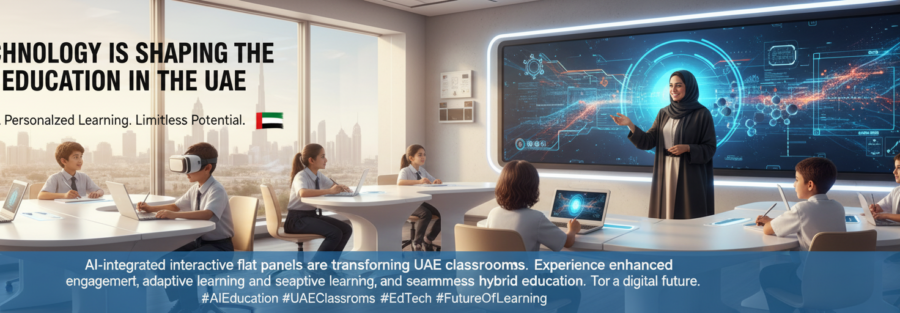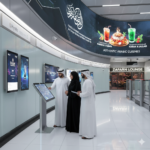How AI Technology Is Shaping the Future of Education in the UAE!
In the evolving landscape of education, technology is no longer a novelty—it is the backbone of modern instruction. Among the many innovations reshaping learning environments, AI-integrated interactive flat panels stand out as powerful tools that merge visual engagement, real-time analytics, and adaptive pedagogy. In the UAE and beyond, schools are embracing these smart classroom solutions to deliver richer, more personalized learning.
From Static Boards to Smart Panels: A Paradigm Shift
Traditional whiteboards, overhead projectors, and static slides have long been staples of classroom instruction. But they limit spontaneity, restrict interactivity, and assume a one-size-fits-all approach. Interactive flat panel displays bring a paradigm shift: high-resolution, touch-enabled surfaces where digital content, multimedia, and live annotations converge. When augmented with AI capabilities—such as handwriting recognition, gesture control, language translation, and learning analytics—these panels evolve into intelligent partners in instruction.
Engagement Elevated: AI Enhances Interactivity
One of the greatest strengths of AI-augmented interactive flat panels is their ability to turn passive learners into active participants. Students can manipulate 3D models, annotate diagrams, drag and drop content, and respond to embedded quizzes—all within the same interface. With AI, these interactions can be contextually interpreted: for instance, the system might recognize that a student is struggling with a concept (by seeing repeated errors), and prompt a scaffolded hint or alternate explanation.
In the UAE, where smart classrooms are becoming mainstream, the adoption of interactive flat panel displays is accelerating across schools and universities. This emphasis on interactivity helps align with the UAE’s vision of future-ready education and digital literacy.
Personalization & Adaptive Learning at Scale
No two students learn exactly alike. AI empowers interactive panels to adapt content in real time. Based on a student’s responses, pace, and error patterns, the system can dynamically present alternate problems, scaffolded hints, or divergent paths of exploration. This personalization ensures that each student stays challenged without becoming overwhelmed.
Teachers also benefit: built-in analytics on student performance help them spot knowledge gaps early. In the UAE, where the Ministry of Education is pushing for AI integration in curriculum and assessment, these data-driven insights are becoming ever more critical.
Hybrid & Remote Learning: Bridging the Physical & Virtual
In a post-pandemic world, flexibility is key. AI-integrated interactive flat panels support seamless hybrid learning: built-in cameras, microphones, wireless casting, and synchronized annotation enable remote students to see and participate as though they were physically present. Teachers can share screens, mirror content, or stream live lessons. This convergence makes the panel a hub of real-time collaboration across rooms or continents.
In UAE smart classrooms, this capability aligns with national initiatives to modernize education and ensure equitable access for all learners—even those joining from home or satellite campuses.
Supporting Teachers: Efficiency, Guidance, and Insight
AI does not replace teachers—it empowers them. With a smart panel, educators can:
Use AI-assisted lesson design, where the system suggests relevant media, questions, or interactive paths.
Save and replay annotated lessons (e.g. screen recording), allowing students to revisit challenging points.
Use AI-driven performance dashboards to track class and individual progress, helping them tailor interventions.
Automate routine tasks such as grading objective questions or summarizing student responses.
Such features reduce administrative burden and free teachers to focus on higher-order tasks: mentoring, discussion, and differentiated instruction.
Inclusivity, Language Support & Accessibility
One of the most compelling potentials of AI integration is support for diverse learners. Interactive flat panels with AI can offer:
Real-time translation (e.g. between Arabic and English) for multilingual classrooms.
Speech-to-text and text-to-speech features that assist students with learning differences.
Adaptive interfaces that adjust font size, contrast, or input mode based on learner needs.
In the UAE’s multicultural education context, these features help bridge language and accessibility gaps, making classrooms more inclusive.
Challenges & Considerations
While promising, the integration of AI-interactive panels must be approached thoughtfully:
Teacher training & adoption: Even the best tool fails if instructors are not confident using it. Ongoing professional development is essential.
Infrastructure & cost: High upfront costs for hardware, network bandwidth, and maintenance can be barriers—especially for underfunded schools.
Data privacy & ethics: Student performance and interaction data must be handled securely, with transparency about algorithmic decisions.
Overreliance on automation: Schools should guard against replacing pedagogical judgment with AI; human oversight remains vital.
Conclusion: Towards Future-Ready Classrooms
AI-integrated interactive flat panels are more than flashy gadgets—they represent a strategic shift in how teaching and learning co-exist. In the UAE’s drive toward “smart education” and AI literacy, these panels double as instructional tools and data hubs, bridging the gap between pedagogy and insight. As more schools adopt “interactive flat panel displays UAE” and “AI classroom technology UAE,” they will not only engage learners more deeply but also better prepare them for a future in which digital fluency is nonnegotiable.



![]() +971 4266 3315 |
+971 4266 3315 | ![]() +971 56 365 4908
+971 56 365 4908



